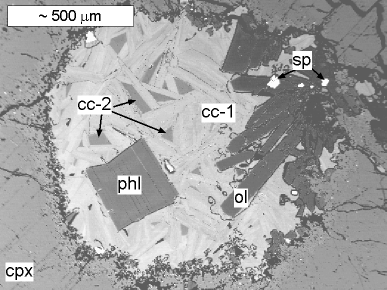CARBONATITES AT 200KM: QUENCHED MELT INCLUSIONS IN MEGACRYSTALLINE LHERZOLITE XENOLITHS, SLAVE CRATON, CANADA
E. van Achterbergh1, W. L. Griffin1, K. Kivi2,
N. J. Pearson1 and S. Y. O'Reilly1
1GEMOC Macquarie
2Kennecott Canada Exploration Inc.
Introduction: Megacrystalline lherzolite xenoliths from the A154 kimberlite (Slave Craton) were derived from the lower lithosphere (ca 1235 oC and 60 kbar) and contain abundant inclusions of quenched carbonatite melt. This study presents the first major and trace element data for a deep-seated carbonatite melt, which was shielded from interaction with mantle and crustal wall-rock by the clinopyroxene (cpx) host as it traveled to the surface.
Sample Description: Globular carbonate-rich inclusions (0.8 to 5.8 mm in diameter) occur within large (>2cm) crystals of Cr-diopside. Orthopyroxene (opx) exsolution parallels the cleavage planes of the host cpx and the opx lamellae extend to the edges of the inclusions, indicating that the entrapment of the globules preceded the opx exsolution. The inclusions consist of Ti-rich phlogopite (phl), Cr-spinel (sp), radiating "spinifex" olivine (ol) and rare perovskite set in a matrix of fresh calcite (Fig. 1). Calcite occurs as two microstructural types: elongate randomly-oriented euhedral crystals (cc-1) and interstitial calcite (cc-2). The globular shape of the inclusions indicates that they were molten when trapped in the cpx; this entrapment probably occurred at >1235 °C, as suggested by the presence of opx exsolution in the cpx. The quenched microstructures and the thermodynamic instability of calcite at the calculated mantle pressures imply that the constituent phases crystallised during transport in the kimberlite, calcite crystallising last at low pressure.
Similar cpx megacrysts from the same locality also contain trapped globules of ultramafic silicate composition (kimberlite?), and some of these show unmixing of silicate and carbonate into concentric rings. In some cases, globules of ultramafic silicate, sulfide and carbonate composition occur together in the same cpx grain.
Carbonatite Composition: Carbonatite melt compositions were calculated for each inclusion using electron microprobe analyses of the constituent phases and modal abundances derived from image analysis. This yields a wide range of compositions along the join between calcium- and magnesium carbonatites. The variation may reflect initial heterogeneity of the carbonatite melt and/or sampling of different volumes of the melt during sectioning. The average melt composition (in weight%) is: SiO2=12.0, TiO2=0.22, Al2O3=0.88, Cr2O3=0.29, FeO=2.6, MnO=0.17, MgO=12.5, CaO=37.1, Na2O=0.03, K2O=0.72, NiO=0.05, Cl=0.002, F=0.02, SrO=1.2, BaO=1.8, P2O5=0.15, CO2=30.5. The ca# varies from 40.7 to 87.2, reflecting the modal abundance of olivine. In contrast, the mg# is constrained between 88.4 and 90.2, consistent with equilibrium between the carbonatite melt and mantle peridotite. The calcite does not contain any Mg(CO3); all Mg and Fe in the original melt is concentrated in the olivine and phlogopite.
Sr and Ba are concentrated in cc-1, depleting the late interstitial cc-2 in these elements. Preliminary trace element analyses indicate that the carbonatite is depleted in Nb and rare earth elements compared with carbonatites associated with alkaline igneous complexes. Olivine in the inclusions is depleted in Ni (average=1160 ppm).
Discussion: This carbonatite is enriched in Si and depleted in Na compared with those produced experimentally by partial melting of carbonated peridotite. Its association with globules of ultramafic silicate melts suggests that the carbonatite was derived from an asthenospheric silicate-carbonate melt (e.g. [1]) that unmixed near the base of the lithosphere. These unusual samples offer new insights into the processes that produce both kimberlites and carbonatites, and on their metasomatic effects in the lithosphere.
Reference:[1] Wyllie, P.J. (1980) JGR, 85, 6902-6910.

Figure 1: (a) Backscattered electron image of a carbonatite
melt inclusion within a megacrystalline cpx grain; abbreviations as in
the text.

 GEMOC ARC National Key Centre
GEMOC ARC National Key Centre